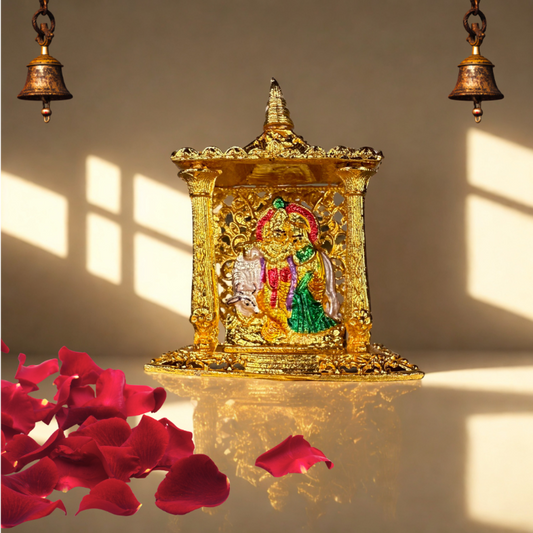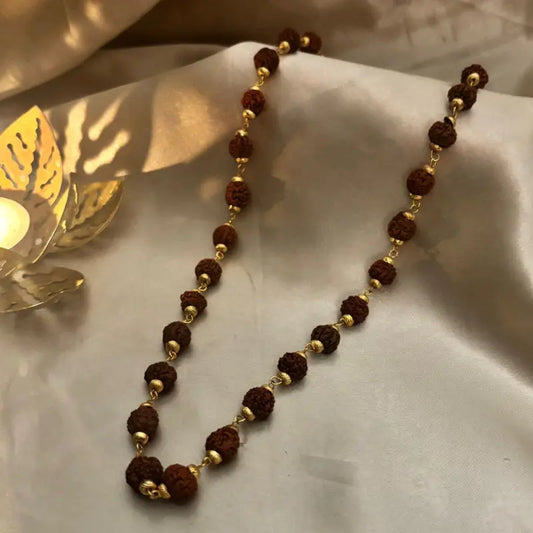
Sustainable Fragrance Rituals: The Eco-Friendly Path from Sambrani Cups to Mandir Essentials
Share
In an era where sustainability is no longer optional but essential, even spiritual and ritual practices are evolving toward greener, more conscious choices. For devotees and spiritually minded households, fragrance is integral: incense, sambrani cups, dhoop, camphor, etc.
However, many traditional incense products use charcoal, synthetic binders, and chemical additives that pollute indoor air and leave non-biodegradable residue. In contrast, an eco-friendly incense ritual uses natural ingredients, biodegradable materials, and low emissions, in short, a sustainable fragrance ethos.
Here’s how you can transform your daily pooja and spiritual rituals into a greener, healthier practice and how Dharmik steps in to support that shift through its incense cups, tulsi malas, mandir essentials, and herbal incense.

The Tradition of Sambrani & Its Modern Reinvention
Sambrani (also called loban, benzoin resin) has been used in Indian rituals for centuries. The fragrant smoke is believed to purify the aura, ward off negative energies, and sanctify the space. But historically, many sambrani offerings were mixed with charcoal, synthetic dyes, or resin extenders, which degrade air quality and accumulate residue.
Modern eco-friendly sambrani cups, also known as havan cups, are designed differently. They use natural herbs, resins, dried temple flowers, organic binders or naturally derived clays, and avoid charcoal or synthetic additives. These sustainable versions burn clean, leave minimal ash, and often decompose without harming the environment. (For example, some brands explicitly advertise "100% biodegradable, eco-friendly, chemical-free" sambrani cups as a sustainable alternative to synthetic incense).
When you integrate such refined sambrani cups into your pooja routine, you're preserving the traditional fragrance ritual while reducing environmental harm, a core tenet of sustainable fragrance.
The Timeless Fragrance of Sambrani: Tradition, Revived
For generations, sambrani has been revered for its sacred aroma and purifying qualities. It was once prepared using pure resins and herbs, burned slowly in clay cups to cleanse the home and calm the mind. Over time, however, commercial production introduced synthetic fillers and charcoal, diluting both its purity and purpose.
The return of eco-friendly sambrani cups is restoring that lost authenticity. Handcrafted from natural materials and designed to burn cleanly, they represent devotion in its purest form. Among the finest of these are Dhamrik’s premium incense cups, crafted from 100% Shuddh Desi Gobar (pure Indian cow dung), a material long valued in Vedic tradition for its purifying and antiseptic qualities. These cups are enriched with aromatic botanicals like Loban, Hauberrai, Nagarmishta, Kaphoor, Kochari, Sugandh Kokila, Guggal, Hauberra, and natural Rose fragrance, creating a divine blend that transforms every ritual into a serene experience.
When lit, the Dhamrik incense cup releases gentle, sacred smoke that cleanses the surroundings while spreading warmth and calmness. Whether used for daily pooja, meditation, or special ceremonies, its fragrance feels as if the ancient traditions themselves have been reborn, sustainable, soulful, and pure.

Why Choose an Eco-Friendly Incense Cup?
Here’s what sustainable incense (especially sambrani cups) brings to the table:
- Lower Indoor Pollution: Conventional incense sticks or charcoal-based sambrani can emit particulate matter, volatile organic compounds (VOCs), and residual soot. Eco-friendly cups, by contrast, limit or eliminate these harmful emissions.
- Biodegradability & Compostability: After burning, the ash or residual shell of eco sambrani cups can often be composted or returned to the earthThere are no plastic or chemical binders to worry about.
- Wildcrafted or Waste-Upcycled Ingredients:Some brands or artisans collect discarded temple flowers, dry them, and use them in incense formulations — turning “waste” into sacred fragrance. This circular approach enriches spiritual practice with ecological purpose.
- Gentler, Balanced Aromatics:Natural herb blends yield soft, complex aromas that don’t overpower. Subtle notes of sandalwood, jatamansi, guggul, tulsi, or rose can emerge, aiding calmness during meditation, prayer, or mindfulness.
- Supporting Ethical & Local Crafts: Eco incense often involves small-scale producers or women artisans, creating livelihoods with respect for tradition and the environment.
Thus, choosing a sambrani cup isn’t just about fragrance; it’s a holistic choice that aligns devotion with sustainability.
Sustainable Mandir Practices: Small Acts, Lasting Impact
Transforming your mandir into a sustainable space doesn’t require sweeping change, only conscious intention. Begin with the essentials.
Replace chemically processed incense with herbal or cow dung-based sambrani cups, like those crafted by Dharmik, which purify naturally and leave behind compostable ash. Use brass or clay diyas, natural oils, and cotton wicks. Place fresh flowers instead of plastic decorations. Let your Tulsi mala rest nearby, symbolising devotion rooted in nature.
Every object becomes part of a living ecosystem; your mandir essentials are no longer just ritual tools but reflections of gratitude to the earth. The fragrance of Guggal and rose from the incense cups mingles with the diya’s soft glow, filling the space with serenity and reverence. It’s not forced luxury, it’s quiet, graceful sustainability.
How to Use a Sambrani Cup Safely & Effectively
- Place the cup on a heat-resistant fibre disc or stand. Many sambrani sets come with a small ceramic or fibre felt pad.
- Ignite the outer rim gently, and allow it to smoulder. Blow off the small flame, and the cup will release aromatic smoke.
- Avoid airflow drafts; let the smoke waft slowly upward.
- After it finishes burning, allow it to cool and then dispose of or compost the residue (if biodegradable).
- Ensure proper ventilation — open a window or door slightly to let fresh air cycle.
- Store unused cups in an airtight container, away from moisture.
With just a few minutes each ritual, the sambrani cup becomes a refined, fragrant offering.

The Aromatic & Spiritual Benefits of Sustainable Fragrances
When choosing eco incense, the benefits aren’t just ecological — they resonate spiritually, mentally, and physically.
- Purifies the ambience: The gentle aromatic smoke is believed to cleanse negative energies or lingering psychic residue.
- Supports focus & calm: The soft fragrance aids concentration during mantra, meditation, or introspection.
- Reduces allergy load: Since there are no harsh chemicals or heavy soot, sensitive individuals may find it more tolerable.
- Aligns with karma & dharma: Your act of offering fragrance becomes an aligned choice offering not just to the deity, but to the planet.
- Cultivates conscious ritual: You become more attentive to what you burn, the source, and your waste, turning ritual into a learning, mindful practice.
Thus, sustainable fragrance isn’t a compromise; it upgrades your spiritual environment.
Tips to Build an Eco-Fragrance Ritual Practice
- Start small: Use one sambrani cup per evening ritual rather than many sticks.
- Mix aromatic layers: Combine sambrani with a mild herbal incense to enrich complexity.
- Rotate scents: Alternate between tulsi, sandalwood, rose, or resin blends to avoid habituation.
- Collect ashes smartly: If the residue is compostable, save it and mix it into your garden soil (if safe). Otherwise, discard respectfully.
- Batch ritual days: On festival or full-moon days, plan a “fragrance offering” for the whole morning with multiple cups and incense.
- Share & gift: Introducing friends or family to Dhamrik’s incense cups or malas can spread sustainable ritual awareness.

Frequently Asked Questions (FAQs)
-
What exactly is a sambrani cup?
A sambrani cup is a small moulded disc or cup made from resin (often benzoin), herbs, dried floral matter, and binders (natural clay or food-grade gum). When lit, it moulders and releases fragrance without a full flame. It’s often used in havan, poojas, or spiritual cleansing rituals. -
How is a sustainable sambrani cup different from ordinary incense?
Sustainable cups avoid charcoal, synthetic binders, artificial perfumes, and plastic packaging. They use biodegradable ingredients and produce cleaner smoke with minimal residue. -
Are these eco incense cups safe indoors?
Yes, when used with care: place on heat-resistant holders, ensure good ventilation, and avoid drafts. Sensitive individuals or asthma patients should test with one cup and monitor the reaction. -
What is the burning time of one cup?
Typically between 10–20 minutes, depending on cup diameter, airflow, and formulation. -
Can I reuse a partially burned cup?
It’s not recommended that most cups burn unevenly once partially used. It’s better to use a fresh cup for a full, balanced aroma. -
How do I dispose of the residual ash or shell?
If your incense cup is fully biodegradable, you can compost it or bury it in soil (if free of heavy additives). Otherwise, discard respectfully in dry waste. Avoid washing into drains. -
Will the scent overpower in small rooms?
No sustainable incense is intentionally mild and balanced. If your room is small, light one candle or reduce the count; open a window slightly to allow fresh air circulation. -
How can I transition my whole mandir setup sustainably?
Start with fragrance (switch to eco cups or herbal incense), then shift your diya oils, cotton wicks, camphor, and pooja samagri to green alternatives. Gradually replace plastic or chemically treated items with recycled, biodegradable, or minimally processed options.
In the intersection of devotion and ecology lies a powerful possibility: offering fragrance that honours both the divine and the earth. With Dharmik as your companion, your spiritual practice can become part of a larger regenerative cycle. Light a sambrani cup, breathe in its gentle smoke, chant with your tulsi mala, and sense that your offerings rise not only to the deity but also contribute to a sustainable, conscious future.





